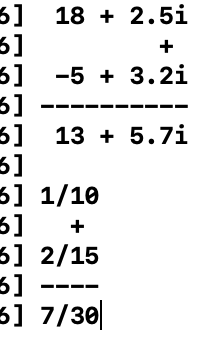多态、动态类型和动态绑定
作者:追风剑情 发布于:2019-2-22 14:16 分类:Objective-C
多态能够使来自不同类的对象定义相同的方法。动态类型能使程序直到执行时才确定对象所属的类。动态绑定则能使程序直到执行时才确定实际要调用的对象的方法。示例一:多态
Fraction.h
- #import <Foundation/Foundation.h>
- @interface Fraction : NSObject
- //@property指令让编译器自动为numerator、denominator生成getter、setter方法
- @property int numerator, denominator;
- -(void) print;
- +(int) printCallCount;
- -(double) convertToNum;
- -(void) setTo: (int) n over: (int) d;
- -(void) set: (int) n : (int) d;
- -(Fraction *) add: (Fraction *) f;
- -(void) reduce;
- @end
Fraction.m
- #import "Fraction.h"
- @implementation Fraction
- @synthesize numerator, denominator;
- // 统计所有对象调用print方法的次数,默认值为0
- static int printCount;
- // 静太方法
- +(int) printCallCount
- {
- return printCount;
- }
- -(void) print
- {
- printCount++;
- //统计本实例对象调用print方法的次数,局部静态变量只会在方法第一次调用时初始化一次
- static int printCountIns = 0;
- printCountIns++;
- NSLog(@"%i/%i", numerator, denominator);
- }
- -(double) convertToNum
- {
- if (denominator != 0)
- return (double) numerator / denominator;
- else
- return NAN;
- }
- // 多个参数的方法
- -(void) setTo: (int) n over: (int) d
- {
- numerator = n;
- denominator = d;
- }
- // 省略参数名的多个参数方法
- // 注意,第一个参数名不能省
- // 省略参数名不是一种好的编程风格,因为它使程序很难读懂并且很不直观,特别是参数很重要时。
- -(void) set: (int) n : (int) d
- {
- numerator = n;
- denominator = d;
- }
- // 分数相加
- -(Fraction *) add: (Fraction *) f
- {
- // 添加两个分数
- // a/b+c/d=((a*d)+(b*c))/(b*d)
- // 创建一个新对象来存储结果
- Fraction *result = [[Fraction alloc] init];
- result.numerator = numerator * f.denominator + denominator * f.numerator;
- result.denominator = denominator * f.denominator;
- // self关键字相当于C#的this
- // [self reduce];
- [result reduce];
- return result;
- }
- // 约分
- -(void) reduce
- {
- int u = numerator;
- int v = denominator;
- int temp;
- while (v != 0) {
- temp = u % v;
- u = v;
- v = temp;
- }
- numerator /= u;
- denominator /= u;
- }
- @end
Complex.h
- #import <Foundation/Foundation.h>
- @interface Complex : NSObject
- @property double real, imaginary;
- -(void) print;
- -(void) setReal: (double) a andImaginary: (double) b;
- -(Complex *) add: (Complex *) f;
- @end
Complex.m
- #import "Complex.h"
- @implementation Complex
- @synthesize real, imaginary;
- -(void) print
- {
- NSLog(@" %g + %gi ", real, imaginary);
- }
- -(void) setReal: (double) a andImaginary: (double) b
- {
- real = a;
- imaginary = b;
- }
- -(Complex *) add: (Complex *) f
- {
- Complex *result = [[Complex alloc] init];
- result.real = real + f.real;
- result.imaginary = imaginary + f.imaginary;
- return result;
- }
- @end
main.m
- #import <Foundation/Foundation.h>
- #import "Fraction.h"
- #import "Complex.h"
- int main(int argc, const char * argv[]) {
- @autoreleasepool {
- Fraction *f1 = [[Fraction alloc] init];
- Fraction *f2 = [[Fraction alloc] init];
- Fraction *fracResult;
- Complex *c1 = [[Complex alloc] init];
- Complex *c2 = [[Complex alloc] init];
- Complex *compResult;
- [f1 setTo: 1 over: 10];
- [f2 setTo: 2 over: 15];
- [c1 setReal: 18.0 andImaginary: 2.5];
- [c2 setReal: -5.0 andImaginary: 3.2];
- // 将两个复数加相并显示
- [c1 print]; NSLog(@" +"); [c2 print];
- NSLog(@"----------");
- compResult = [c1 add: c2];
- [compResult print];
- NSLog(@"\n");
- // 将两个分数相加并显示
- [f1 print]; NSLog(@" +"); [f2 print];
- NSLog(@"----");
- fracResult = [f1 add: f2];
- [fracResult print];
- // Fraction和Complex都有add和print方法
- // 使不同的类共享相同方法名称的能力称为多态
- }
- return 0;
- }
示例二:动态绑定和id类型
main.m
- #import <Foundation/Foundation.h>
- #import "Fraction.h"
- #import "Complex.h"
- int main(int argc, const char * argv[]) {
- @autoreleasepool {
- id dataValue;
- Fraction *f1 = [[Fraction alloc] init];
- Complex *c1 = [[Complex alloc] init];
- [f1 setTo: 2 over: 5];
- [c1 setReal: 10.0 andImaginary: 2.5];
- // 动态绑定
- // 存储在id变量中的对象类型在编译时无法确定,一些测试推迟到运行时进行
- // id变量不能使用点运算符
- dataValue = f1;
- [dataValue print];
- dataValue = c1;
- [dataValue print];
- }
- return 0;
- }
运行测试
| 处理动态类型的方法 | ||
| 方法 | 问题或行为 | |
| -(BOOL) isKindOfClass: class-object | 对象是不是class-object或其子类的成员 | |
| -(BOOL) isMemberOfclass: class-object | 对象是不是class-object的成员 | |
| -(BOOL) respondsToSelector: Selector | 对象是否能够响应selector所指定的方法 | |
| +(BOOL) instancesRespondToSelector: Selector | 指定的类实例是否能响应selector | |
| +(BOOL) isSubclassOfClass: class-object | 对象是否是指定类的子类 | |
| -(id) performSelector: selector | 应用selector指定的方法 | |
| -(id) performSelector: selector withObject: object | 应用selector指定的方法,传递参数object | |
| -(id) performSelector: selector withObject: object1 withObject2 object2 | 应用selector指定的方法,传递参数object1和object2 | |
示例三
用到了之前文章中的Rectangle类、Square类
参见 http://www.devacg.com/?post=924
main.m
- #import <Foundation/Foundation.h>
- #import "Square.h"
- #import "Rectangle.h"
- int main(int argc, const char * argv[]) {
- @autoreleasepool {
- Square *mySquare = [[Square alloc] init];
- // isMemberOf: 测试类中的直接成员关系
- if ( [mySquare isMemberOfClass: [Square class]] == YES )
- NSLog(@"mySquare is a member of Square class");
- if ( [mySquare isMemberOfClass: [Rectangle class]] == YES )
- NSLog(@"mySquare is a member of Rectangle class");
- if ( [mySquare isMemberOfClass: [NSObject class]] == YES )
- NSLog(@"mySquare is a member of NSObject class");
- // isKindOf: 检测继承层次中的关系
- if ( [mySquare isKindOfClass: [Square class]] == YES )
- NSLog(@"mySquare is a kind of Square");
- if ( [mySquare isKindOfClass: [Rectangle class]] == YES )
- NSLog(@"mySquare is a kind of Rectangle");
- if ( [mySquare isKindOfClass: [NSObject class]] == YES )
- NSLog(@"mySquare is a kind of NSObject");
- // respondsTo:
- if ( [mySquare respondsToSelector: @selector (setSide:)] == YES )
- NSLog(@"mySquare responds to setSide: method");
- if ( [mySquare respondsToSelector: @selector (setWidth:andHeight:)] == YES )
- NSLog(@"mySquare responds to setWidth:andHeight: method");
- if ( [Square respondsToSelector: @selector (alloc)] == YES )
- NSLog(@"Square responds to alloc method");
- // instancesRespondTo:
- if ( [Rectangle instancesRespondToSelector: @selector (setSide:)] == YES )
- NSLog(@"Instances of Rectangle respond to setSide: method");
- if ( [Square instancesRespondToSelector: @selector (setSide:)] == YES )
- NSLog(@"Instances of Square respond to setSide: method");
- if ( [Square isSubclassOfClass: [Rectangle class]] == YES )
- NSLog(@"Square is a subclass of a rectangle");
- }
- return 0;
- }
标签: Objective-C
« 使用@try处理异常
|
覆盖方法»
日历
最新文章
随机文章
热门文章
分类
存档
- 2025年3月(4)
- 2025年2月(3)
- 2025年1月(1)
- 2024年12月(5)
- 2024年11月(5)
- 2024年10月(5)
- 2024年9月(3)
- 2024年8月(3)
- 2024年7月(11)
- 2024年6月(3)
- 2024年5月(9)
- 2024年4月(10)
- 2024年3月(11)
- 2024年2月(24)
- 2024年1月(12)
- 2023年12月(3)
- 2023年11月(9)
- 2023年10月(7)
- 2023年9月(2)
- 2023年8月(7)
- 2023年7月(9)
- 2023年6月(6)
- 2023年5月(7)
- 2023年4月(11)
- 2023年3月(6)
- 2023年2月(11)
- 2023年1月(8)
- 2022年12月(2)
- 2022年11月(4)
- 2022年10月(10)
- 2022年9月(2)
- 2022年8月(13)
- 2022年7月(7)
- 2022年6月(11)
- 2022年5月(18)
- 2022年4月(29)
- 2022年3月(5)
- 2022年2月(6)
- 2022年1月(8)
- 2021年12月(5)
- 2021年11月(3)
- 2021年10月(4)
- 2021年9月(9)
- 2021年8月(14)
- 2021年7月(8)
- 2021年6月(5)
- 2021年5月(2)
- 2021年4月(3)
- 2021年3月(7)
- 2021年2月(2)
- 2021年1月(8)
- 2020年12月(7)
- 2020年11月(2)
- 2020年10月(6)
- 2020年9月(9)
- 2020年8月(10)
- 2020年7月(9)
- 2020年6月(18)
- 2020年5月(4)
- 2020年4月(25)
- 2020年3月(38)
- 2020年1月(21)
- 2019年12月(13)
- 2019年11月(29)
- 2019年10月(44)
- 2019年9月(17)
- 2019年8月(18)
- 2019年7月(25)
- 2019年6月(25)
- 2019年5月(17)
- 2019年4月(10)
- 2019年3月(36)
- 2019年2月(35)
- 2019年1月(28)
- 2018年12月(30)
- 2018年11月(22)
- 2018年10月(4)
- 2018年9月(7)
- 2018年8月(13)
- 2018年7月(13)
- 2018年6月(6)
- 2018年5月(5)
- 2018年4月(13)
- 2018年3月(5)
- 2018年2月(3)
- 2018年1月(8)
- 2017年12月(35)
- 2017年11月(17)
- 2017年10月(16)
- 2017年9月(17)
- 2017年8月(20)
- 2017年7月(34)
- 2017年6月(17)
- 2017年5月(15)
- 2017年4月(32)
- 2017年3月(8)
- 2017年2月(2)
- 2017年1月(5)
- 2016年12月(14)
- 2016年11月(26)
- 2016年10月(12)
- 2016年9月(25)
- 2016年8月(32)
- 2016年7月(14)
- 2016年6月(21)
- 2016年5月(17)
- 2016年4月(13)
- 2016年3月(8)
- 2016年2月(8)
- 2016年1月(18)
- 2015年12月(13)
- 2015年11月(15)
- 2015年10月(12)
- 2015年9月(18)
- 2015年8月(21)
- 2015年7月(35)
- 2015年6月(13)
- 2015年5月(9)
- 2015年4月(4)
- 2015年3月(5)
- 2015年2月(4)
- 2015年1月(13)
- 2014年12月(7)
- 2014年11月(5)
- 2014年10月(4)
- 2014年9月(8)
- 2014年8月(16)
- 2014年7月(26)
- 2014年6月(22)
- 2014年5月(28)
- 2014年4月(15)
友情链接
- Unity官网
- Unity圣典
- Unity在线手册
- Unity中文手册(圣典)
- Unity官方中文论坛
- Unity游戏蛮牛用户文档
- Unity下载存档
- Unity引擎源码下载
- Unity服务
- Unity Ads
- wiki.unity3d
- Visual Studio Code官网
- SenseAR开发文档
- MSDN
- C# 参考
- C# 编程指南
- .NET Framework类库
- .NET 文档
- .NET 开发
- WPF官方文档
- uLua
- xLua
- SharpZipLib
- Protobuf-net
- Protobuf.js
- OpenSSL
- OPEN CASCADE
- JSON
- MessagePack
- C在线工具
- 游戏蛮牛
- GreenVPN
- 聚合数据
- 热云
- 融云
- 腾讯云
- 腾讯开放平台
- 腾讯游戏服务
- 腾讯游戏开发者平台
- 腾讯课堂
- 微信开放平台
- 腾讯实时音视频
- 腾讯即时通信IM
- 微信公众平台技术文档
- 白鹭引擎官网
- 白鹭引擎开放平台
- 白鹭引擎开发文档
- FairyGUI编辑器
- PureMVC-TypeScript
- 讯飞开放平台
- 亲加通讯云
- Cygwin
- Mono开发者联盟
- Scut游戏服务器引擎
- KBEngine游戏服务器引擎
- Photon游戏服务器引擎
- 码云
- SharpSvn
- 腾讯bugly
- 4399原创平台
- 开源中国
- Firebase
- Firebase-Admob-Unity
- google-services-unity
- Firebase SDK for Unity
- Google-Firebase-SDK
- AppsFlyer SDK
- android-repository
- CQASO
- Facebook开发者平台
- gradle下载
- GradleBuildTool下载
- Android Developers
- Google中国开发者
- AndroidDevTools
- Android社区
- Android开发工具
- Google Play Games Services
- Google商店
- Google APIs for Android
- 金钱豹VPN
- TouchSense SDK
- MakeHuman
- Online RSA Key Converter
- Windows UWP应用
- Visual Studio For Unity
- Open CASCADE Technology
- 慕课网
- 阿里云服务器ECS
- 在线免费文字转语音系统
- AI Studio
- 网云穿
- 百度网盘开放平台
- 迅捷画图
- 菜鸟工具
- [CSDN] 程序员研修院
- 华为人脸识别
- 百度AR导航导览SDK
- 海康威视官网
- 海康开放平台
- 海康SDK下载
- git download
- Open CASCADE
- CascadeStudio
交流QQ群
-
Flash游戏设计: 86184192
Unity游戏设计: 171855449
游戏设计订阅号









